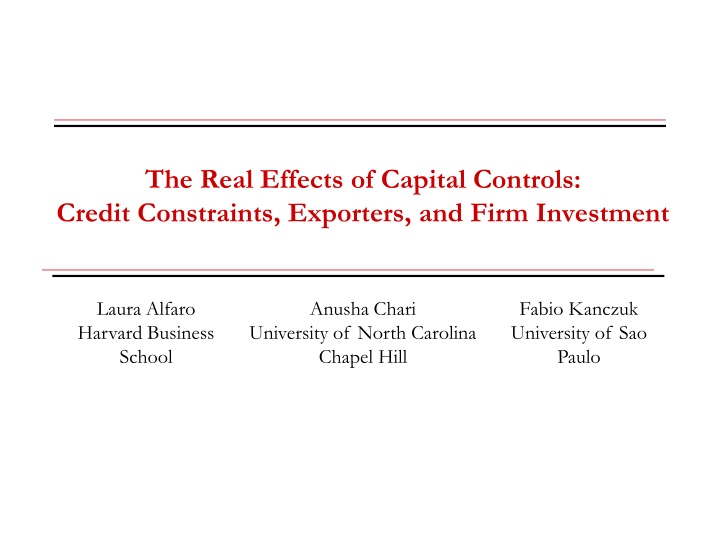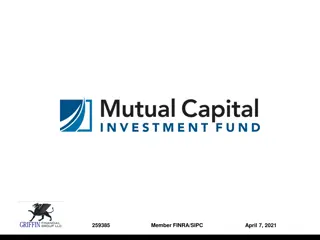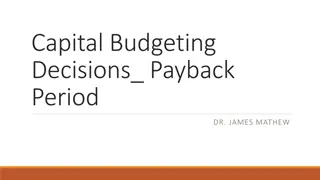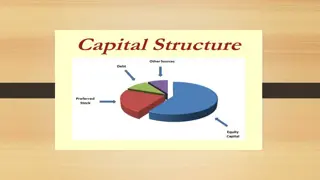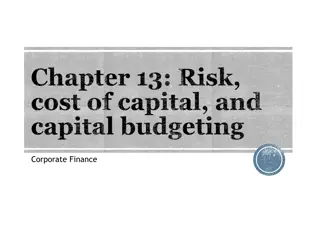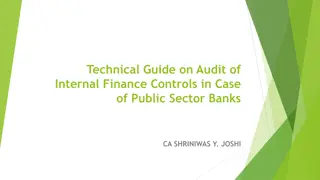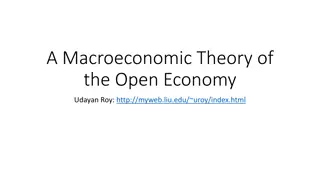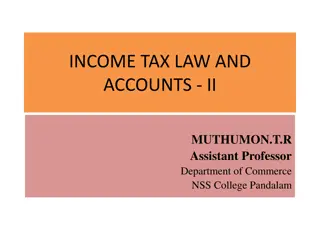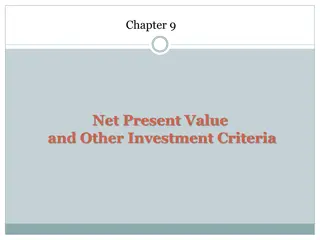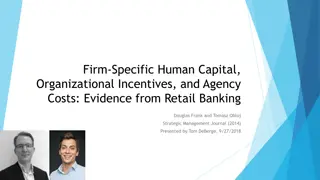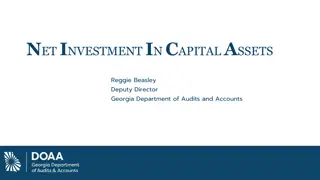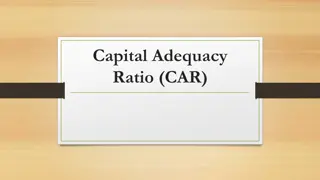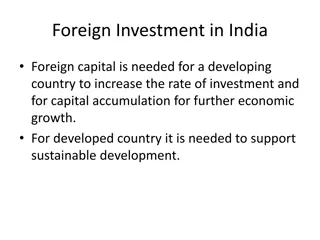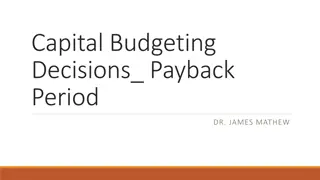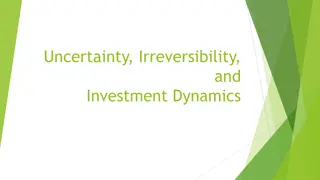Effects of Capital Controls on Firm Investment
This study explores the impact of capital controls on credit constraints, exporters, and firm investment using Brazilian data. It delves into the rationale and macro-micro level analysis of capital controls, focusing on the effects at the firm level. The research evaluates stock returns and real investment responses in the context of capital flow regulations implemented in Brazil between 2008-2012.
Download Presentation

Please find below an Image/Link to download the presentation.
The content on the website is provided AS IS for your information and personal use only. It may not be sold, licensed, or shared on other websites without obtaining consent from the author.If you encounter any issues during the download, it is possible that the publisher has removed the file from their server.
You are allowed to download the files provided on this website for personal or commercial use, subject to the condition that they are used lawfully. All files are the property of their respective owners.
The content on the website is provided AS IS for your information and personal use only. It may not be sold, licensed, or shared on other websites without obtaining consent from the author.
E N D
Presentation Transcript
The Real Effects of Capital Controls: Credit Constraints, Exporters, and Firm Investment Laura Alfaro Harvard Business School Anusha Chari Fabio Kanczuk University of Sao Paulo University of North Carolina Chapel Hill
The Rationale for Capital Controls Macro-prudential Concerns: Mitigate the volatility of foreign capital inflows. Protectionism: Prevent currency appreciation. "The US printed a lot of money, so there's a lot of hot money flowing around. We see hot money in Taiwan and elsewhere in Asia These short-term capital flows are disturbing emerging economies. -Perng Fai-Nan
Macro-Micro Level Analysis An extensive empirical literature has focused on the aggregate effects of capital controls. (Magud, Reinhart, and Rogoff, 2011). Macroeconomic analysis do not shed light on the channels through which capital controls can affect the economy at the micro-level. Studies about the effects of capital controls on firm-activity are relatively scarce (Forbes 2007a, b). Data availability for emerging markets being an obvious constraint.
Firm-Level Analysis Using Brazilian Data Evaluate the effects of capital controls on firm-level stock returns & real investment using data from Brazil. Brazil has implemented a series of controls on capital flows in the last 5 years. The stock market in Brazil is relatively well developed: Value stocks traded above 40% and 65% market cap. % GDP, 2007- 2012 (WDI, WB). Firm-level and export data: Firm-level response to capital flows as well as the impact of capital controls on exporting firms, (Datastream, Secex). Event-study methodology around the dates when the various capital control measures were announced using stock prices and firm level data.
Table 1: Capital Controls in Brazil, 2008-2012 Equity Event Date Debt Event Event 3/12/2008 IOF tax=1.5% on fixed income investments made by non-residents 10/22/2008 IOF tax=0% on fixed income investments following the collapse of Lehman Brothers IOF tax=2% introduced on equities and fixed income securities 10/19/2009 11/18/2009 Tax=1.5% on American Depositary Receipts (ADRs) converted into local stocks 10/4/2010 IOF tax=4% on fixed income bonds and derivatives 10/18/2010 IOF tax=6% on fixed income bonds and derivatives 3/28/2011 IOF tax=6% on overseas loans and bonds with maturities up to 1 year 4/6/2011 IOF tax to overseas bonds and bonds with maturities up to 2 years 7/26/2011 Tax of 1% on foreign exchange derivatives; legislation allow tax to be increased up to 25% 12/1/2011 IOF tax=0% on variable income instruments traded on the exchange and certain debentures 2/29/2012 IOF tax to cover overseas loans and bonds with maturities up to 3 years 3/9/2012 IOF tax to cover overseas loans and bonds with maturities up to 5 years 5/21/2012 IOF tax=1.5% for individual borrowers (from 2.5%) 6/13/2012 IOF tax to overseas loans and bonds with maturities up to 2 years 12/4/2012 IOF tax to overseas loans and bonds with maturities up to 1 year
The Imposition of Capital Controls Constitutes a Move Away from Financial Openness. Changes in expected returns will depend on changes in firm-specific systematic risk Expected returns will rise for firms whose exposure to systematic risk increases and fall for those whose exposure decreases following capital controls announcements. The change in expected returns will be reflected in stock prices. How? Required Rates of Return Expected Future Cash Flows All else equal, stock prices will fall if the market imputes an increase in expected returns or the firm-specific cost of capital or a decrease in expected future cash flows.
Real Effects at the Firm-Level Credit constraints at the firm level are more likely to bind for firms that are more dependent on external finance (Chaney (2008), Rajan & Zingales (1998)). Frequent changes to capital controls can increase uncertainty while reducing the availability and increase the cost of external finance, which can lower investment at the firm-level.
Event-Study Methodology Announcement effect of capital controls news: If capital markets are semi-strong form efficient to public information, stock prices will quickly following an announcement (Andrade et al., 2001). Two-day window: most stringent test to capture the announcement effect of the capital controls with less concern about other confounding news events.
Results Significant decline in cumulative abnormal returns following changes in capital controls. Controls on equity flows are associated with significantly more negative returns. Firm characteristics: Large firms and exporting firms are less affected by the controls. The largest exporting firms (>$100 million) are less affected. Firms that are more dependent on external finance are more adversely affected by the imposition of capital controls. Investment declines significantly for small, non-exporting firms that are dependent on external finance. Exporters increase investment.
Roadmap Theoretical underpinnings Event study methodology The Data Results Conclusion
Capital Controls Reduce International Diversification Opportunities Complete financial market integration implies that:: = + * i * f * f [ ] ( [ E R ] ) E R r r iW W Assume a country imposes capital controls segmenting its stock market from the rest of the world. Assume also that expected future cash flows remain unchanged. Market segmentation will reduce the diversification opportunities for foreign investors (effects magnified if domestic investors are limited in ability to invest abroad). The relevant pool of investors will tilt towards domestics. For any individual stock: [ ] i f iM E R r = + ( [ E R ] ) r M f Depending on the level of controls the change in expected returns will reflect a range from complete to partial segmentation. Alternatively, controls create a price wedge in the expected returns or a tax that drives up the expected return relative to the benchmark return under full integration.
Capital Control & Stock Prices 1. Risk-free rate effect. 2. Firm-specific risk premium effect. 3. Expected cash flow effect. If some firms benefit from the protectionism, expected cash flows could increase more than the rise in the required rate of return such that stock prices rise.
Data Stock price data from Datastream. Data about firm characteristics are taken from Worldscope. BOVESPA (most common index in Brazil). For robustness use other indices such as IBRA. We use quarterly data from Q1 2006-Q4 2012. Proxy for size: the (log) of total assets (sales). Proxy liquidity: debt to total assets and short term debt to total debt. Lagged one year deflated by CPI. The firm level information was matched to export status and the range of exports using data from the Brazilian Secretary of External Trade (Secretaria de Comercio Exterior, Secex). The export range is in US$ (FOB) and includes firm exporting less than $1million, between $1 million and $100 million, and above $100 million.
Main Specification The basic regression specification is as follows: (3) ?????= ???????? + ??????????????+ ??? ?????is the cumulative abnormal return for firm i over the event window t. Firm controls include a set of firm-specific characteristics such as size, leverage, etc. Robust/clustered standard errors.
Cumulative Abnormal Returns are Negative & Significant when Capital Controls are Announced (Table 4) (1) (2) Constant -0.00428*** -0.0339*** -0.0348*** (0.001) (0.012) Log Total Assets 0.00177*** (0.000661) Exporter (6) (7) -0.0354*** (0.0108) 0.00173*** (0.000640) (0.0113) 0.00169** (0.000672) 0.00508* (0.00262) Export < $1 mil -0.00570 (0.00509) 0.00823+ (0.00548) 0.00532** (0.00234) 941 0.0152 Export $1 mil -$100 mil Export > $100 mil Observations R-squared 1,000 0.000 941 0.006 941 0.0103
Debt vs. Equity Events Similar pattern of results holds with highly significant negative cumulative abnormal returns (Table 5). Controls on equity flows in Panel B display a more negative announcement effect (Columns 2-4, 6-7) compared to controls on debt flows in Panel A. T-tests of means confirm differences. For equity related announcements the short term debt ratio is negative and significant overall -4.8% decline (Panel B, Column 4) Firms with higher levels of short-term debt are perhaps more dependent on external finance in the form of short-term debt or equity and therefore the imposition of controls on equity flows has an even more negative effect on firm returns.
Table 6: External Finance Dependence Drives Abnormal Returns The constant is negative & significant ranging from -2.3% to -3.68%. External finance dependence drives down abnormal returns further in alternative specifications. -(CE-CF)/CE -(CE-CF)/CE > mean (dummy) -(CE-CF)/CE (continuous) (manufacturing dummy) Large firms and exporters are somewhat shielded firm size and export coefficients are positive & significant. Coefficient on small exporter variable is negative & significant.
Investment: Before and After Regime Change (Table 7) 3/12/2008 10/19/2009 Before After T-test Before After T-test 1. All Firms 5.6% 5.3% 5.7% 1.7% 2. Size Assets> 1.9% 4.1% 2.6% 1.5% 17.7% 6.2% *** 8.9% 1.7% * Assets< 3. Export Exporting 7.8% 3.1% 2.7% 5.6% * Non Exporting 4.0% 4.1% 7.9% -1.0% * 4. Liquidity CE-CF/CE> 6.5% 3.2% * 5.2% 1.1% -0.5% 17.8% * 8.8% 3.7% CE-CF/CE<
Robustness Checks and Additional Tests Different windows and different methodologies for computing returns (raw returns, CAPM). Two-way clustered standard errors. Firms on the alternative IBRA stock exchange. Dropped the event with the most negative abnormal returns on 10/22/2008 which also coincides with the global financial crisis. IPO of OGX (June-2008). Share of debt to bank (negative and significant); and sales as an alternative proxy of size. Quantile (median) regressions for our main specifications. Easing and tightening events separately.
Discussion The evidence in this paper suggests that capital controls can: increase market uncertainty reduce the availability of external finance lower investment at the firm-level. Implications for macro models that focus on aggregate variables to examine the optimality of capital controls & abstract from heterogeneity at the firm-level. In particular, the evidence suggests that capital controls disproportionately affect small, non-exporting firms especially those more dependent on external finance.
